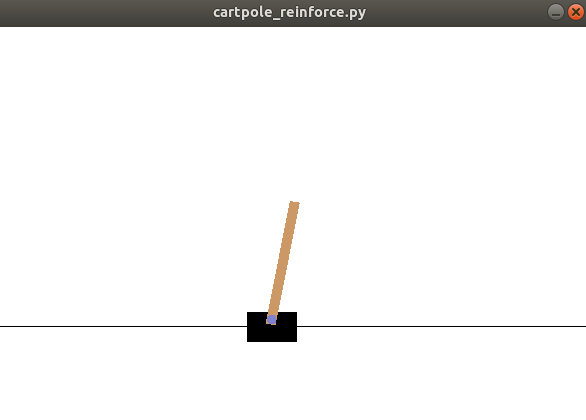深度增强学习--Deep Q Network
从这里开始换个游戏演示,cartpole游戏


import sys
import gym
import pylab
import random
import numpy as np
from collections import deque
from keras.layers import Dense
from keras.optimizers import Adam
from keras.models import Sequential EPISODES = 300 # DQN Agent for the Cartpole
# it uses Neural Network to approximate q function,使用神经网络近似q-learning的q函数
# and experience replay memory & fixed target q network
class DQNAgent:
def __init__(self, state_size, action_size):
# if you want to see Cartpole learning, then change to True
self.render = True
self.load_model = False # get size of state and action
self.state_size = state_size
self.action_size = action_size # These are hyper parameters for the DQN
self.discount_factor = 0.99
self.learning_rate = 0.001
self.epsilon = 1.0
self.epsilon_decay = 0.999
self.epsilon_min = 0.01
self.batch_size = 64
self.train_start = 1000
# create replay memory using deque
self.memory = deque(maxlen=2000) # create main model and target model
self.model = self.build_model()
self.target_model = self.build_model() # initialize target model
self.update_target_model() if self.load_model:
self.model.load_weights("./save_model/cartpole_dqn.h5") # approximate Q function using Neural Network
# state is input and Q Value of each action is output of network
def build_model(self):
model = Sequential()
model.add(Dense(24, input_dim=self.state_size, activation='relu',
kernel_initializer='he_uniform'))
model.add(Dense(24, activation='relu',
kernel_initializer='he_uniform'))
model.add(Dense(self.action_size, activation='linear',
kernel_initializer='he_uniform'))
model.summary()
model.compile(loss='mse', optimizer=Adam(lr=self.learning_rate))
return model # after some time interval update the target model to be same with model
def update_target_model(self):
self.target_model.set_weights(self.model.get_weights()) # get action from model using epsilon-greedy policy
def get_action(self, state):
if np.random.rand() <= self.epsilon:
return random.randrange(self.action_size)
else:
q_value = self.model.predict(state)#2,q(s,a),利用模型预测不同action的q值,选大的作为下一action
return np.argmax(q_value[0]) # save sample <s,a,r,s'> to the replay memory
def append_sample(self, state, action, reward, next_state, done):
self.memory.append((state, action, reward, next_state, done))
if self.epsilon > self.epsilon_min:
self.epsilon *= self.epsilon_decay # pick samples randomly from replay memory (with batch_size)
def train_model(self):
if len(self.memory) < self.train_start:
return
import pdb; pdb.set_trace()
batch_size = min(self.batch_size, len(self.memory))
mini_batch = random.sample(self.memory, batch_size)#64list
#(array([[-0.04263461, -0.00657423, 0.00506589, -0.00200269]]), 0, 1.0, array([[-0.04276609, -0.20176846, 0.00502584, 0.29227427]]), False) update_input = np.zeros((batch_size, self.state_size))
update_target = np.zeros((batch_size, self.state_size))
action, reward, done = [], [], [] for i in range(self.batch_size):
update_input[i] = mini_batch[i][0]
action.append(mini_batch[i][1])
reward.append(mini_batch[i][2])
update_target[i] = mini_batch[i][3]
done.append(mini_batch[i][4]) target = self.model.predict(update_input)#(64,2)
target_val = self.target_model.predict(update_target)#(64, 2) for i in range(self.batch_size):
# Q Learning: get maximum Q value at s' from target model
if done[i]:
target[i][action[i]] = reward[i]
else:
target[i][action[i]] = reward[i] + self.discount_factor * (
np.amax(target_val[i]))#off-policy 更新 # and do the model fit!
self.model.fit(update_input, target, batch_size=self.batch_size,
epochs=1, verbose=0) if __name__ == "__main__":
# In case of CartPole-v1, maximum length of episode is 500
env = gym.make('CartPole-v1')
# get size of state and action from environment
state_size = env.observation_space.shape[0]#
action_size = env.action_space.n# agent = DQNAgent(state_size, action_size) scores, episodes = [], [] for e in range(EPISODES):
done = False
score = 0
state = env.reset()
state = np.reshape(state, [1, state_size]) while not done:
if agent.render:
env.render() # get action for the current state and go one step in environment
action = agent.get_action(state)
next_state, reward, done, info = env.step(action)
next_state = np.reshape(next_state, [1, state_size])
# if an action make the episode end, then gives penalty of -100
reward = reward if not done or score == 499 else -100 # save the sample <s, a, r, s'> to the replay memory
agent.append_sample(state, action, reward, next_state, done)
# every time step do the training
agent.train_model()
score += reward
state = next_state if done:
# every episode update the target model to be same with model
agent.update_target_model() # every episode, plot the play time
score = score if score == 500 else score + 100
scores.append(score)
episodes.append(e)
pylab.plot(episodes, scores, 'b')
pylab.savefig("./save_graph/cartpole_dqn.png")
print("episode:", e, " score:", score, " memory length:",
len(agent.memory), " epsilon:", agent.epsilon) # if the mean of scores of last 10 episode is bigger than 490
# stop training
if np.mean(scores[-min(10, len(scores)):]) > 490:
sys.exit() # save the model
if e % 50 == 0:
agent.model.save_weights("./save_model/cartpole_dqn.h5")
深度增强学习--Deep Q Network的更多相关文章
- AlphaGo的前世今生(一)Deep Q Network and Game Search Tree:Road to AI Revolution
这一个专题将会是有关AlphaGo的前世今生以及其带来的AI革命,总共分成三节.本人水平有限,如有错误还望指正.如需转载,须征得本人同意. Road to AI Revolution(通往AI革命之路 ...
- 强化学习系列之:Deep Q Network (DQN)
文章目录 [隐藏] 1. 强化学习和深度学习结合 2. Deep Q Network (DQN) 算法 3. 后续发展 3.1 Double DQN 3.2 Prioritized Replay 3. ...
- Deep Q Network(DQN)原理解析
1. 前言 在前面的章节中我们介绍了时序差分算法(TD)和Q-Learning,当状态和动作空间是离散且维数不高时可使用Q-Table储存每个状态动作对的Q值,而当状态和动作空间是高维连续时,使用Q- ...
- 【转】【强化学习】Deep Q Network(DQN)算法详解
原文地址:https://blog.csdn.net/qq_30615903/article/details/80744083 DQN(Deep Q-Learning)是将深度学习deeplearni ...
- 深度增强学习--DDPG
DDPG DDPG介绍2 ddpg输出的不是行为的概率, 而是具体的行为, 用于连续动作 (continuous action) 的预测 公式推导 推导 代码实现的gym的pendulum游戏,这个游 ...
- 深度增强学习--A3C
A3C 它会创建多个并行的环境, 让多个拥有副结构的 agent 同时在这些并行环境上更新主结构中的参数. 并行中的 agent 们互不干扰, 而主结构的参数更新受到副结构提交更新的不连续性干扰, 所 ...
- 深度增强学习--Actor Critic
Actor Critic value-based和policy-based的结合 实例代码 import sys import gym import pylab import numpy as np ...
- 深度增强学习--Policy Gradient
前面都是value based的方法,现在看一种直接预测动作的方法 Policy Based Policy Gradient 一个介绍 karpathy的博客 一个推导 下面的例子实现的REINFOR ...
- 深度增强学习--DPPO
PPO DPPO介绍 PPO实现 代码DPPO
随机推荐
- Python学习笔记 - day6 - 函数
函数 函数在编程语言中就是完成特定功能的一个词句组(代码块),这组语句可以作为一个单位使用,并且给它取一个名字.可以通过函数名在程序的不同地方多次执行(这叫函数的调用).函数在编程语言中有基本分为:预 ...
- 网络知识===cookie 、session、JSESSIONID的区别
cookie .session ? 让我们用几个例子来描述一下cookie和session机制之间的区别与联系.笔者曾经常去的一家咖啡店有喝5杯咖啡免费赠一杯咖啡的优惠,然而一次性消费5杯咖啡的机会微 ...
- 【linux】kill ;杀死某一用户下的所有进程
[linux]kill :杀死某一用户下的所有进程 https://my.oschina.net/u/347414/blog/600854
- [ Python - 8 ] 简单demo练习
练习1: 利用os模块编写一个能实现dir -l输出的程序(注意:dir /l是windows下命令) #!_*_coding:utf-8_*_ # Author: hkey import os, t ...
- Spring boot 文件路径读取异常
在开发代码中,有一段需要获取resources目录下的一个配置文件(这里写作test.xml). 这段代码在ide中没有任何问题,但是一打成jar包发布到线上,这段代码就会报找不到对应文件的错误. 按 ...
- Sikuli 安装使用之初体验(为Sikuli X指定jre路径)
Sikuli 是一种新颖的图形脚本语言,在实际的自动化测试中如果仅仅依靠selenium 还是远远不够的,selenium自动化本身是存在着诸多缺陷的,基于浏览器之外的控件 (windows 控件 等 ...
- CentOS 7 安装PHP7+Nginx+Mysql5.7开发环境
安装PHP&PHP-FPM 首先更新一下CentOS7系统,对系统软件做一下升级,这里不升级内核. //使用root权限,注意这里使用upgrade,而不是update(它会升级内核,这里我们 ...
- deepin使用root身份运行
https://blog.csdn.net/guanripeng/article/details/79630619
- 部署web应用到虚拟主机的三种方式
方式一: 在 [tomcat]/conf/server.xml 文件中的<Engine>标签下的<Host>标签内部, 添加一个 <Context ...
- [python] 如何将unicode字符串转换为中文
答案:(http://stackoverflow.com/) ps:这个网站解决了我好多问题啊,大家多上 >>>s='\u9648\u4f1f\u9706\u5176\u5b9e\u ...
